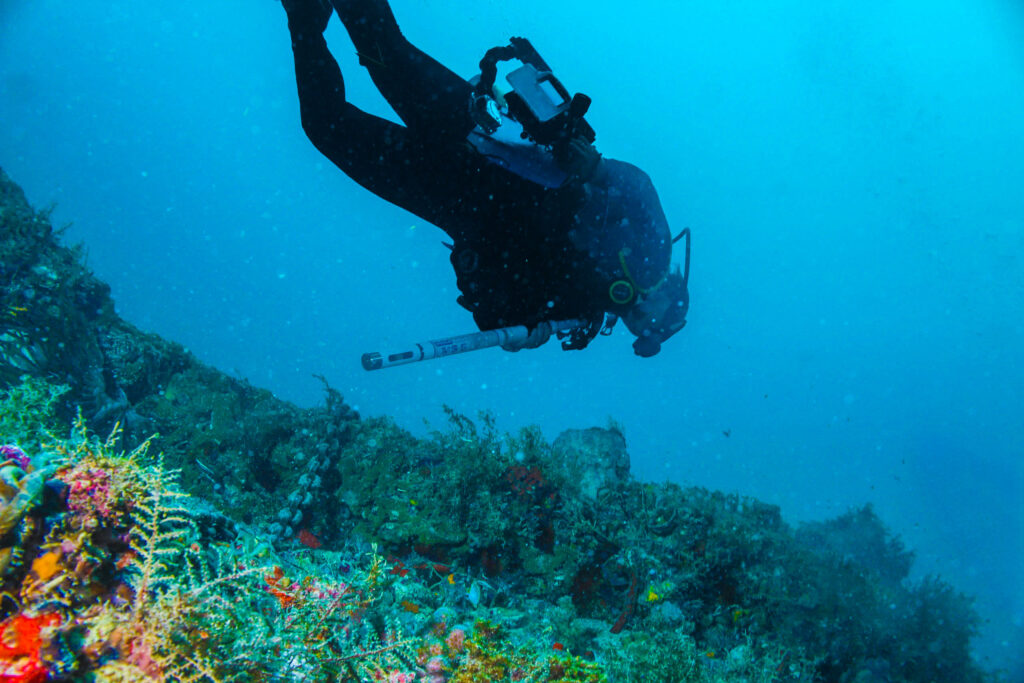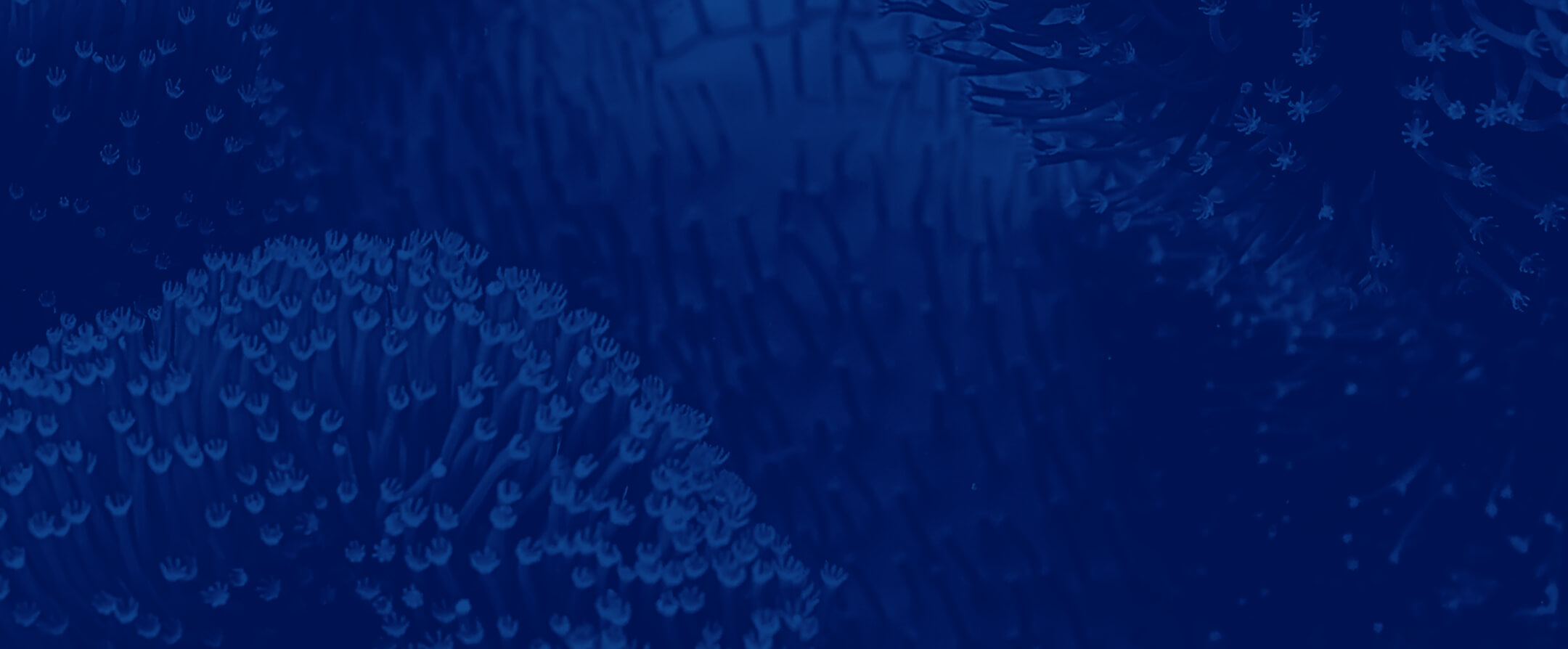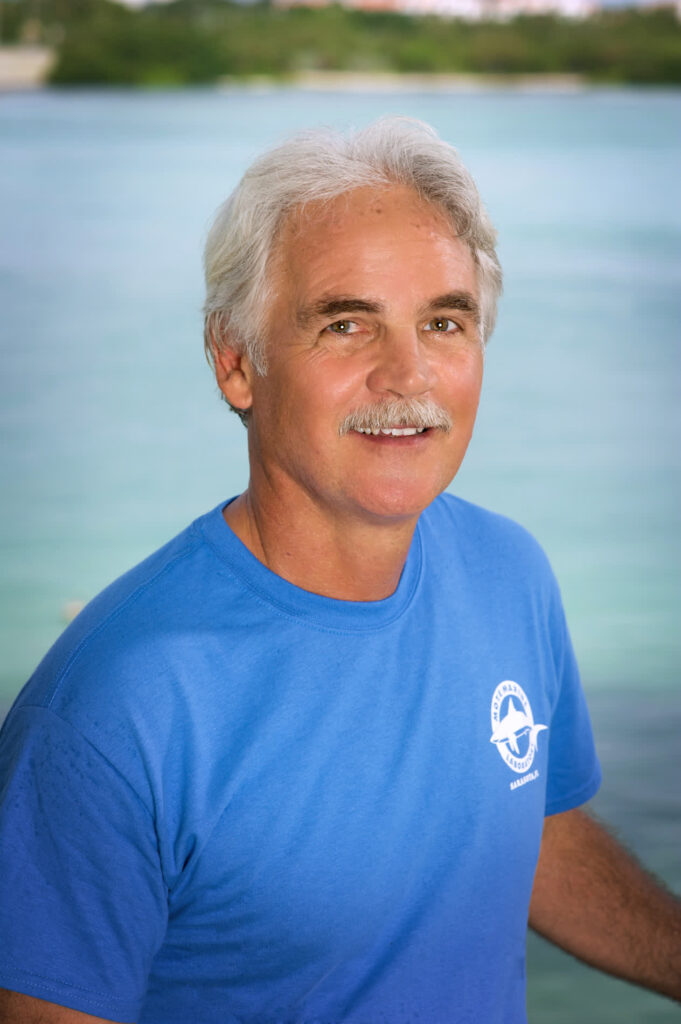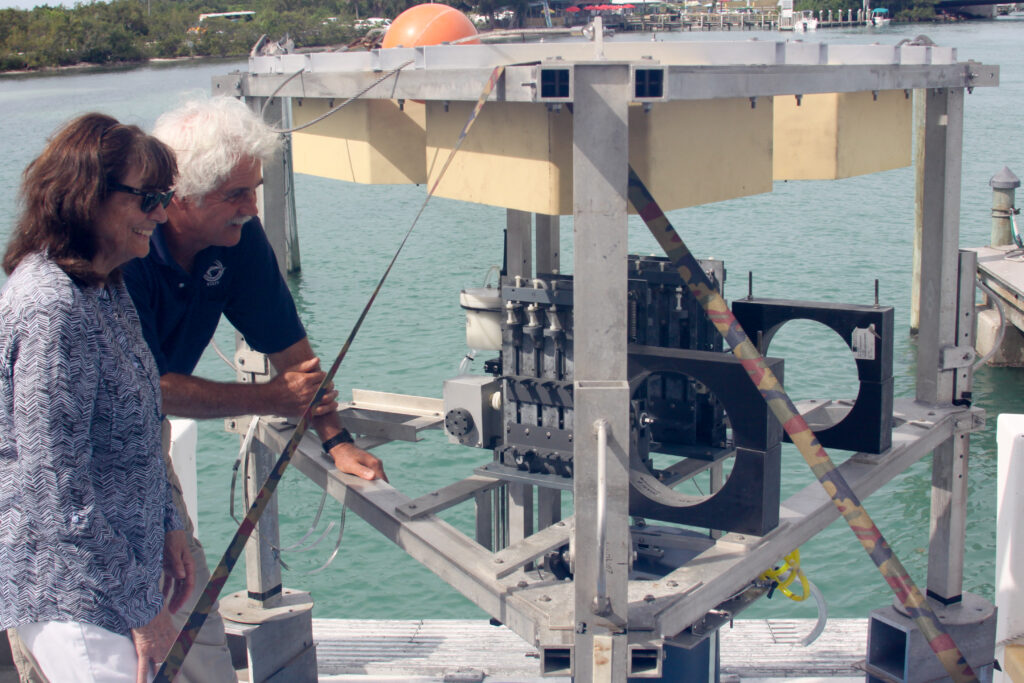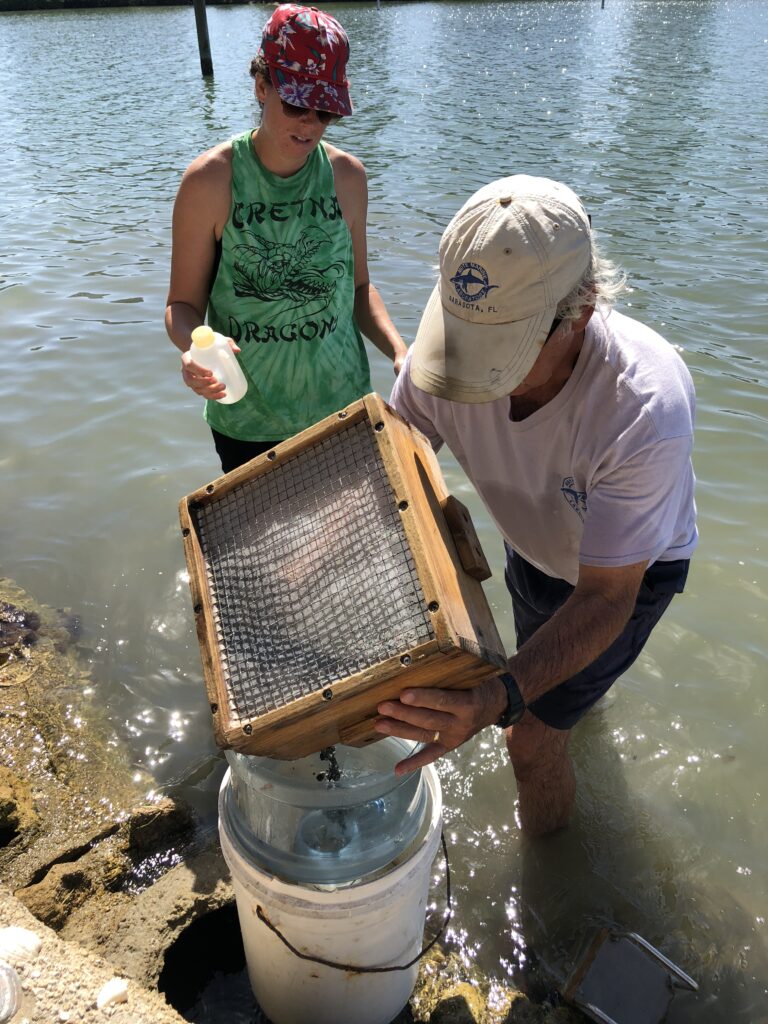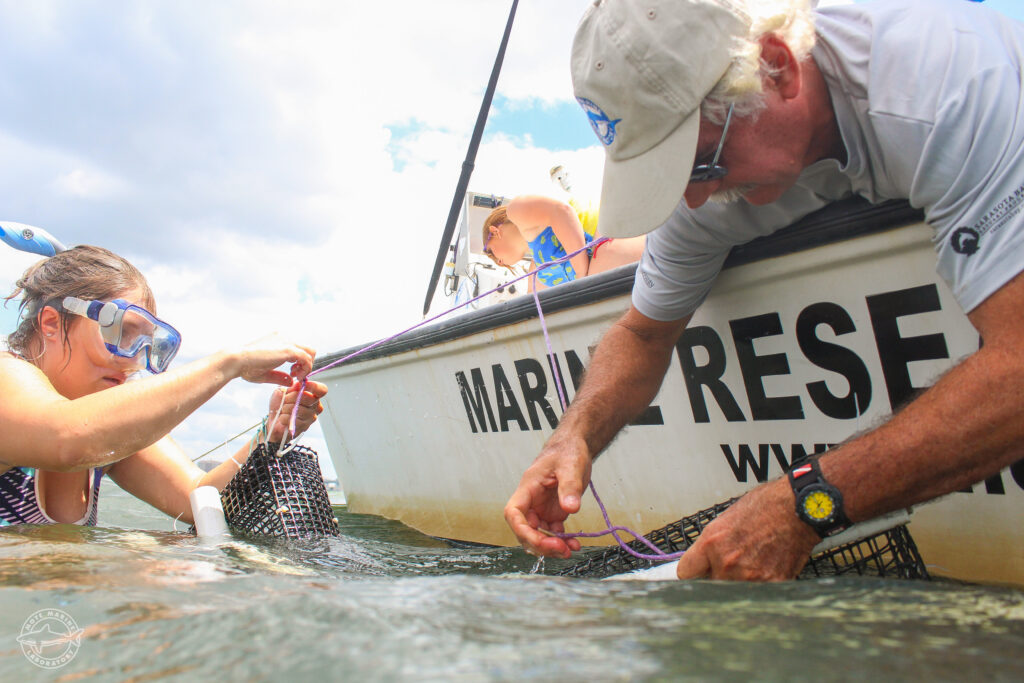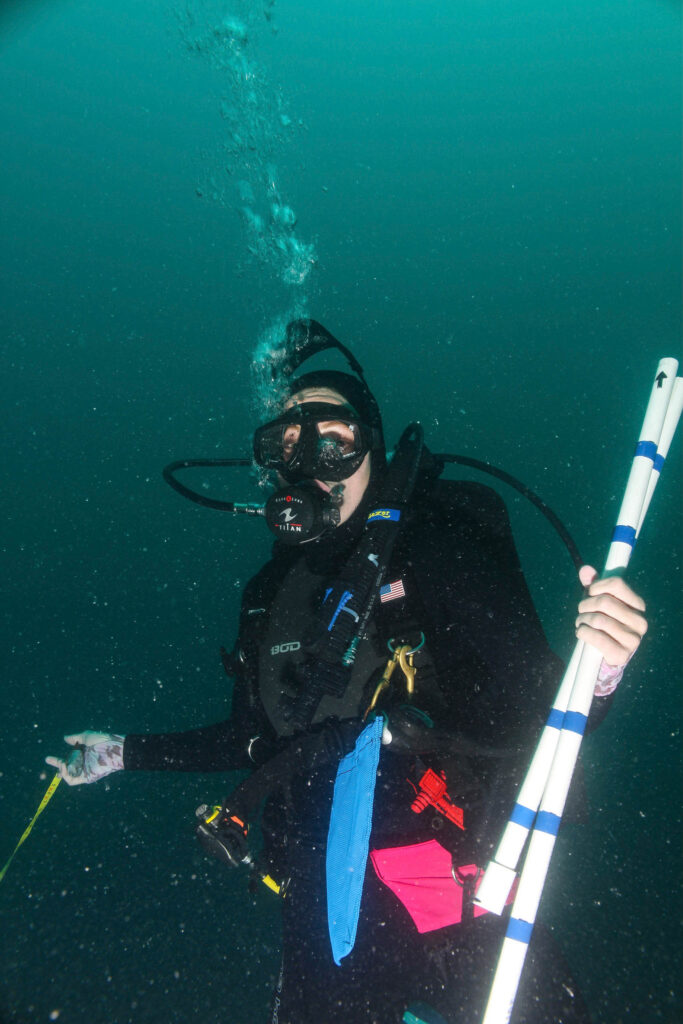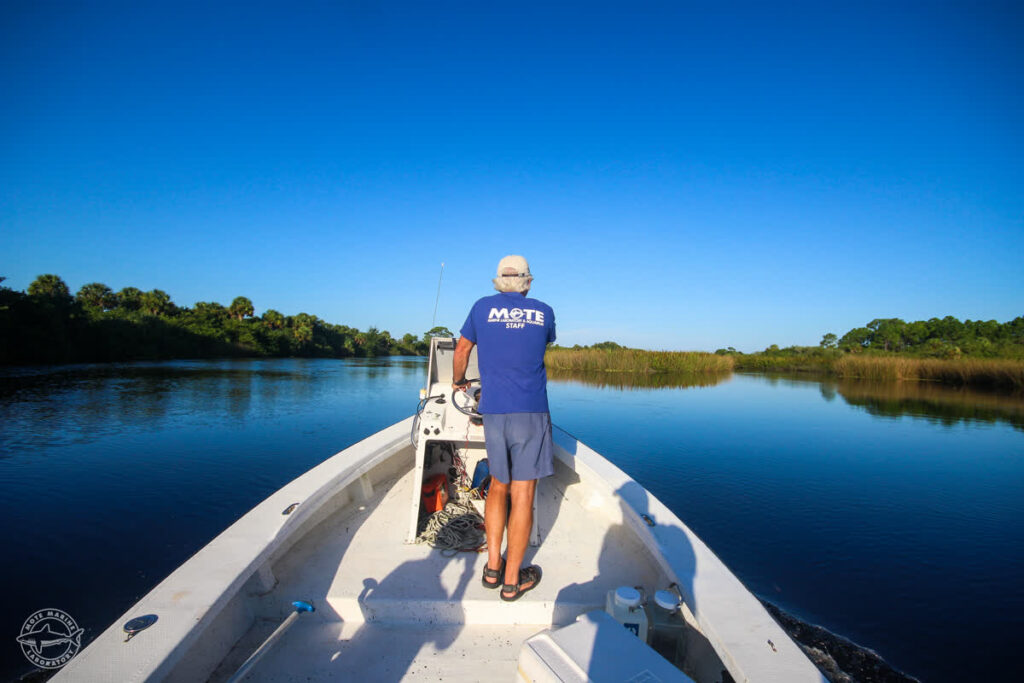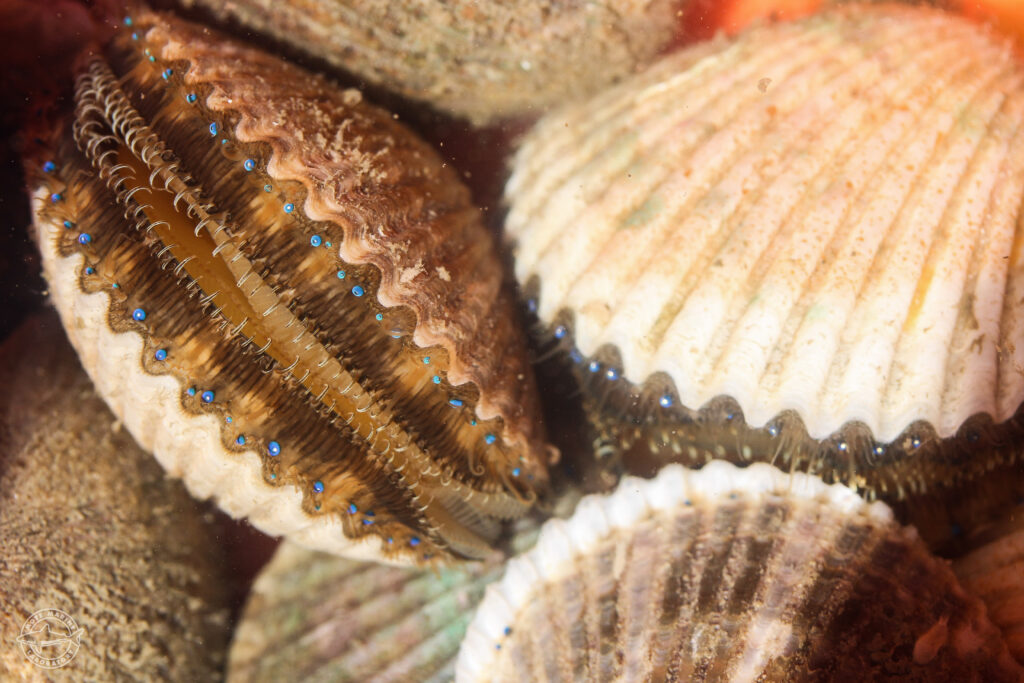Benthic ecology is the study of organisms that make up bottom communities (sediments, seagrass communities and rock outcrops) in lakes, streams, estuaries and oceans, to determine environmental health and conduct environmental impact studies. Mote’s Benthic Ecology Program has conducted many projects primarily using benthic invertebrates to assess the environmental health of areas or regions.
Certain species of invertebrates are representative of a healthy environment, while others may tolerate and be representative of environmental stresses, such as thermal effluents from power plants, excess nutrients or chemical contaminants, alterations of the bottom by dredging or sedimentation and disruption of habitat by alteration of freshwater inflows.
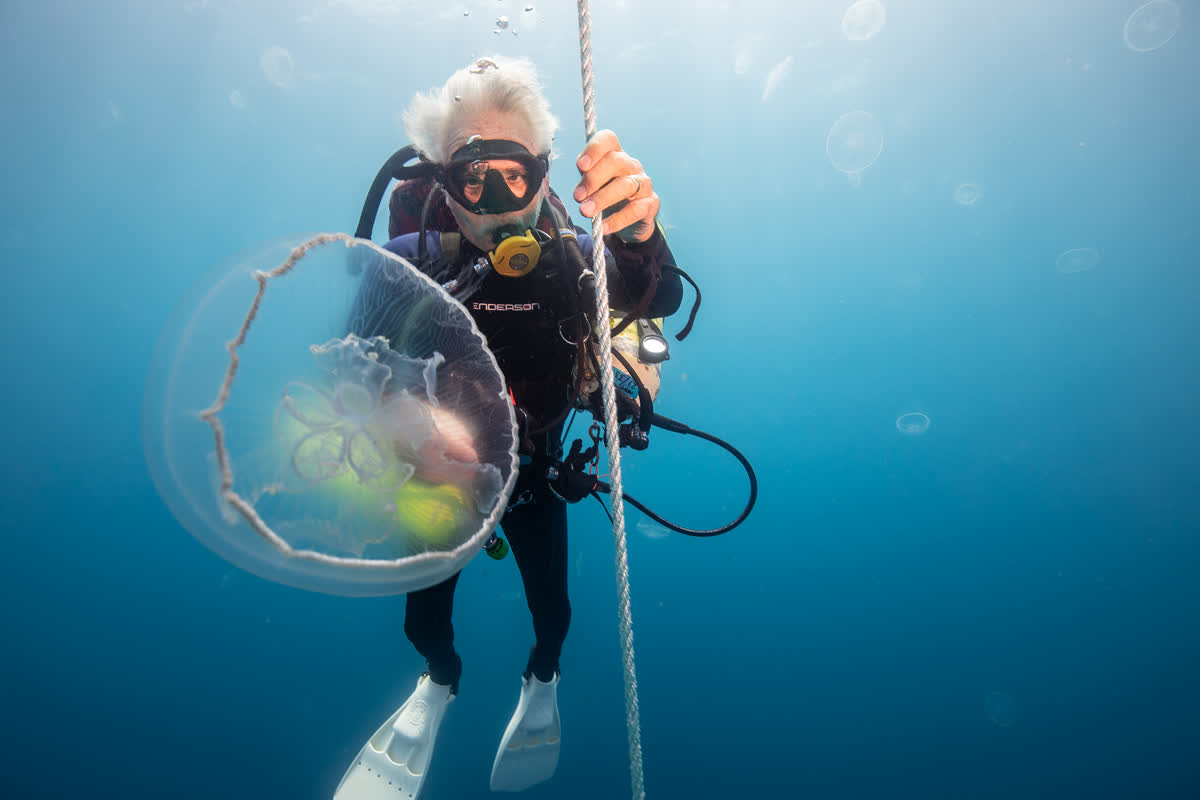
The Program is best known for its pioneering studies of blue holes, underwater caves, springs and sinkholes that house unique microbial communities and host a wide variety of life at their rims. (Read a blue hole blog series.)
Currently the program is researching the possible occurrence of groundwater seepage through the continental shelf into the Gulf of Mexico along the southwest Florida coast. It is hypothesized this groundwater seepage may contain nutrients that could be one method of initiating and or perpetuating red tide (Karenia brevis) blooms. Two recent publications analyzing severe long-term Karenia blooms have detected a cyclical nature of blooms which be related to groundwater seeps forced by inland rainfall.
The program provides environmental characterization and impact studies for government agencies and industry. The program has been involved in habitat surveys including seagrass mapping and bathymetry surveys, benthic biodiversity surveys, artificial reef surveys, coordination of multidiscliplinary studies of power plant impacts, assessments of the upper estuarine invertebrate zonation of tidal rivers, assessment of the impacts of beach restoration, impacts of mosquito larvicides on non-target invertebrates, effects of red tide events on invertebrates, assessment of offshore sand mining, and a variety of other environmental surveys.
The Program has also conducted seagrass and reef mapping, sediment coring, long-term measuring of physical field parameters such as salinity, temperature, weather, and currents.
Benthic Ecology staff also provide invertebrate identification services, and environmental monitoring support such as turbidity monitoring, salinity and dissolved oxygen monitoring, collection and analysis of water current speeds and circulation data and assist with the collection of water quality data for Mote’s state certified environmental water quality laboratory, the Environmental Chemistry Program. The program can also provide expertise in scientific scuba diving in accordance with American Academy of Underwater Sciences (AAUS) rules for scientific diving. Mr. Culter developed the Mote Diving Program and brought Mote into compliance with AAUS and EPA diving standards.
Benthic research at Mote dates to 1978.
Program Details
- Investigation of Groundwater Seeps, Nutrients and Relationship to Karenia brevis Blooms
This project is researching the magnitude of groundwater seepage through the continental shelf into the Gulf of Mexico along the southwest Florida coast. Groundwater in the Floridan aquifer is known to contain excess nutrients originating from agricultural practices in central Florida for over 100 years. Net groundwater flow through the permeable Floridan aquifer is toward the southwest coast and it is highly likely water is forced into the overlying water of the continental shelf through the limestone which is close to the surface in this area. This groundwater seepage likely contain nutrients that could be one driver initiating and or perpetuating red tide (Karenia brevis) blooms. This research has produced two publications. The authors analyzed all data on record in Florida for severe long-term Karenia blooms and have detected a cyclical nature of blooms which may be related to groundwater seeps forced by inland rainfall. - Testing of the Effects of Modified Clay on Benthic Organisms
A modified clay has been found to be capable of removing red tide cells (Karenia brevis) from the water column when applied as a slurry to the surface of the water.During a Karenia bloom the clay sprayed across the surface forms a floc and settles through the water column and the Karenia cells stick to the clay which settles to the bottom, thus clearing the water column of Karenia. This project is examining the effect of the modified clay on non-target benthic invertebrates.
- Sarasota Bay Watch
- Sarasota Bay Estuary Program
- Charlotte Harbor Estuary Program
- Florida Fish and Wildlife Conservation Commission
- University of South Florida
- Environmental Protection Agency
- Woods Hole Oceanographic Institution, Woods Hole, MA
The following partial list is a summary of the major projects conducted by the Benthic Ecology Program.
DREDGING AND DREDGE MATERIAL DISPOSAL
- 2007 Midnight Pass Benthic Faunal Collections, in support of a re-opening permit application.
- 2001 Turbidity Monitoring for a dredge & fill restoration, Tampa Bay
- 1995-1997 Effects of minerals mining on Benthos, offshore Atlantic, Jacksonville, FL
- 1992-1996 Effects of minerals mining on Benthos, nearshore Gulf of Mexico
- 1991-1996 Effects of thin-layer dredged material disposal on the benthos of Mississippi Sound, National demonstration project
- 1987-1989 Analysis of benthic faunal samples from the Charleston Harbor ocean disposal site.
- 1987-1988 Offshore dredged material disposal benthic impacts study, Tampa
- 1987 Ocean disposal site, sampling methodology determination, Tampa
- 1984 Gulf of Mexico disposal site, environmental impact study
- 1982 Dredged material disposal site, Egmont Key, Florida, benthic response and recovery
OTHER INDUSTRIAL/MUNICIPAL IMPACTS
- 1998-2009 Monitoring of benthic fauna in the Vicinity of a RO discharge, Venice, Florida
- 1999 Monitoring of benthic fauna in the Vicinity of a RO discharge, Deerfield Beach, Florida
- 1996-1998 Effect of the Mosquito Larvicide Temephos on Benthic Wetlands Fauna
- 1997 Impacts of Reverse Osmosis discharge on Benthic Fauna, Antigua, Caribbean
- 1993 Natural gas pipeline survey, habitat mapping & sediment profiling, Tampa Bay
- 1990-1991 Kings Bay submarine base, benthic fauna and water quality
- 1988 Alifia River acid spill, benthic impact assessment
- 1981 Effects of treated sewage discharge, Sarasota Bay
- 1980 Gardinier phosphate biogeochemistry & benthic recovery
NEARSHORE, ESTUARINE AND BAY STUDIES
- 2012-present Mote Community Partnership: Scallop Restoration Initiative, private grant funding.
- 2013-present Installation of a multiparameter water and weather monitoring tower in Charlotte Harbor. For: Southwest Florida Water Management District.
- 2010 Field and Logistics Assistance to NOAA Mussel Watch Program. Funded by NOAA.
- 2009-2010 Evaluation of the spatial extent, density and growth rates of barnacles in Crystal, Homosassa and Withlacoochee Rivers, Florida. Southwest Florida Water Management District.
- 2005-2011 Restoration of the Bay scallop, Argopecten irradians, to Pine Island Sound, Tampa and Sarasota Bays. Cooperative research with other groups, various funding sources.
- 2005-2007 Development of a Tidal Creek Index for Sarasota County.
- 2006-2007 Development of a Tidal Creek Condition Index for Sarasota County.
- 2004-2007 Charlotte Harbor Benthic Biodiversity Survey. Charlotte Harbor Estuary Program.
- 2001-2005 Charlotte Harbor Initiative – Benthic Component of multidisiplinary project
- 2000 Data Collection, currents, salinity, in vicinity of a proposed desalination facility.
- 1998 Habitat Delineation and Condition Survey, Castaway Cay, Bahamas
- 1998 Seagrass Mapping of the ICW in the vicinity of Palm Beach Harbor
- 1995-1996 Seagrass and Live-bottom Habitat Mapping, Dade to West Palm Beach Counties
- 1992 Indian River Lagoon benthic invertebrate taxonomy
- 1992 Venice ICW habitat survey
- 1991-1993 St. Andrews bay, benthic taxonomy
- 1990-1992 Sarasota Bay bottom habitat assessment
- 1990 Hard-bottom habitat survey of the nearshore zone, off Venice inlet
- 1989 Dye study and benthic analysis, Pithlachascotee River
- 1987-1989 Natural nearshore suspended solids levels under normal and storm conditions. Vero Beach, Clearwater & Venice.
- 1987 Pascagoula benthic infaunal analysis
- 1986-1989 Marine habitat restoration research, Tampa Bay
- 1982-1984 Southwest Florida shelf ecosystems study, infauna, macroepifauna & video interpretation
- 1980 Marine sampling program, Pinellas County
OFFSHORE STUDIES
- 2018-Present Sponsored by NOAA Ocean Exploration.
- 2005-Present Exploration of the West Florida Shelf Blue Holes Investigation of Physical and Biological Characteristics and Archaeological Implications of Unique Karst Features.
- 2005 through 2007 Sponsored by NOAA Ocean Exploration.
- 2010 Survey of Gulf of Mexico patch-reefs off Sarasota and Manatee Counties.
- 2005 Pulley Ridge Expedition, First Scientific Divers on Pulley Ridge. Harte Foundation.
POWER PLANT IMPACTS
- 2006-2008 Implementation of 316(a) studies TECO Big Bend Power Plant. This multidisciplinary project consists of monitoring various physical and biological components to determine the effects of thermal effluent on the estuarine environment for a once-through cooling power plant.
- 2005-2008 Implementation of 316(b) Impact Monitoring Program, TECO, Bayside
- 2003-2008 Implementation of 316(a) Thermal Monitoring Program, TECO, Bayside
- 2005-2007 316(b) Power Plant Study TECO Bayside
- 2005-2007 316(b) Power Plant Study TECO Big Bend
- 2001-2002 Development/implementation of an Thermal Monitoring Program, TECO, Bayside
- 1991-2001 Development of an Ecological Monitoring Program, TECO, Big Bend
- 1990-1991 FPL Anclote, thermal effects on seagrasses and infauna
- 1979-1986 TECO, Big Bend ecological monitoring program
- 1983-1984 Crystal River 316(a) and (b) demonstrations
- 1978-1979 Review and evaluation of the Anclote 316 demonstration
RIVER-MARINE TRANSITIONAL ZONE
- 2008 Benthic Faunal Identification Chassowitzka & Homosassa Rivers
- 2005-2006 Benthic Faunal Distribution of the Chassowitzka River w/ Respect to Salinity
- 2005-2006 Benthic Faunal Distribution of the Manatee and Braden Rivers w/ Respect to Salinity
- 2004-2006 Lyons, Dona and Roberts Bay Macroinvertebrate Distribution and Abundance
- 2000-2002 Lower Alafia River Study of Benthic Macroinvertebrates
- 1997-2001 Long Term Benthic Monitoring Plan Design, Tidal Peace River
- 1987-1988 Tidal Freshwater Myakka River, benthos
- 1984-1985 Impact of flow reductions on Myakka River estuary
- 1984-1985 West Florida River & estuarine studies
- 1982 Sediments and benthos of the lower Manatee River
BEACH RESTORATION PROJECTS
- 2000-2001 Gasparilla Island Habitat delineation and assessment
- 1998-1999 Natural and Artificial Reef Assessment, Longboat Key, Sarasota County
- 1997 Suspended Solids Monitoring, Hard-Bottom Habitat Mapping, near Ft. Pierce Inlet
- 1991-1996 Longboat Key, Sarasota County
- 1989, 1993 Hutchinson Island, Martin County
- 1991-1992 Lido Beach, Sarasota County
- 1991 Vero Beach, Indian River County
- 1991 Broward County
- 1991 Palm Beach County
- 1990 Near shore hard-bottom community survey, Manatee County
- 1979-1980 Panama City Beach, long term effects of restoration
- 1987, 1990 Marco Island, Collier County
- 1991 Venice Beach, Sarasota County
FRESHWATER, TAXONOMIC and LABORATORY SUPPORT PROJECTS
- 1999-2002 Hog Creek Restoration – Benthic evaluation.
- 1998-1999 Macrofauna from Florida Bay, Funded by Florida Marine Research Institute.
- 1998 Zooplankton & Ichthyoplankton Taxonomy, Caloosahatchee River, FL, SFWMD
- 1996-1997 Macrofauna from Florida Bay, Funded by Florida Marine Research Institute.
- 1996-1998 Freshwater Invertebrate Taxonomic Support, IMC/Agrico Phosphate.
- 1996 Benthic Sampling and Analysis for Sailfish Point, St. Lucie Inlet, Stuart, Florida.
- 1995-1996 Analysis of Benthic Invertebrate and Fish Samples from the Headwaters of Foster Creek, South Carolina.
- 1995-1996 Benthic Invertebrate Taxonomy, Caloosahatchee River, Florida
- 1991-1993 Nova University, polychaete taxonomy
- 1991 St. Lucy Inlet management, benthic survey
- 1989-1991 Puerto Rico, San Juan Harbor, Aguadilla Bay, invertebrate taxonomy
- 1987-1988 Lake Okeechobee, Assessment of aquatic weed harvesting impacts
- 1978-1981 Benthic Fauna of Tampa Bay, a Photographic Taxonomic Manual.
Read About Our Blue Hole Expedition
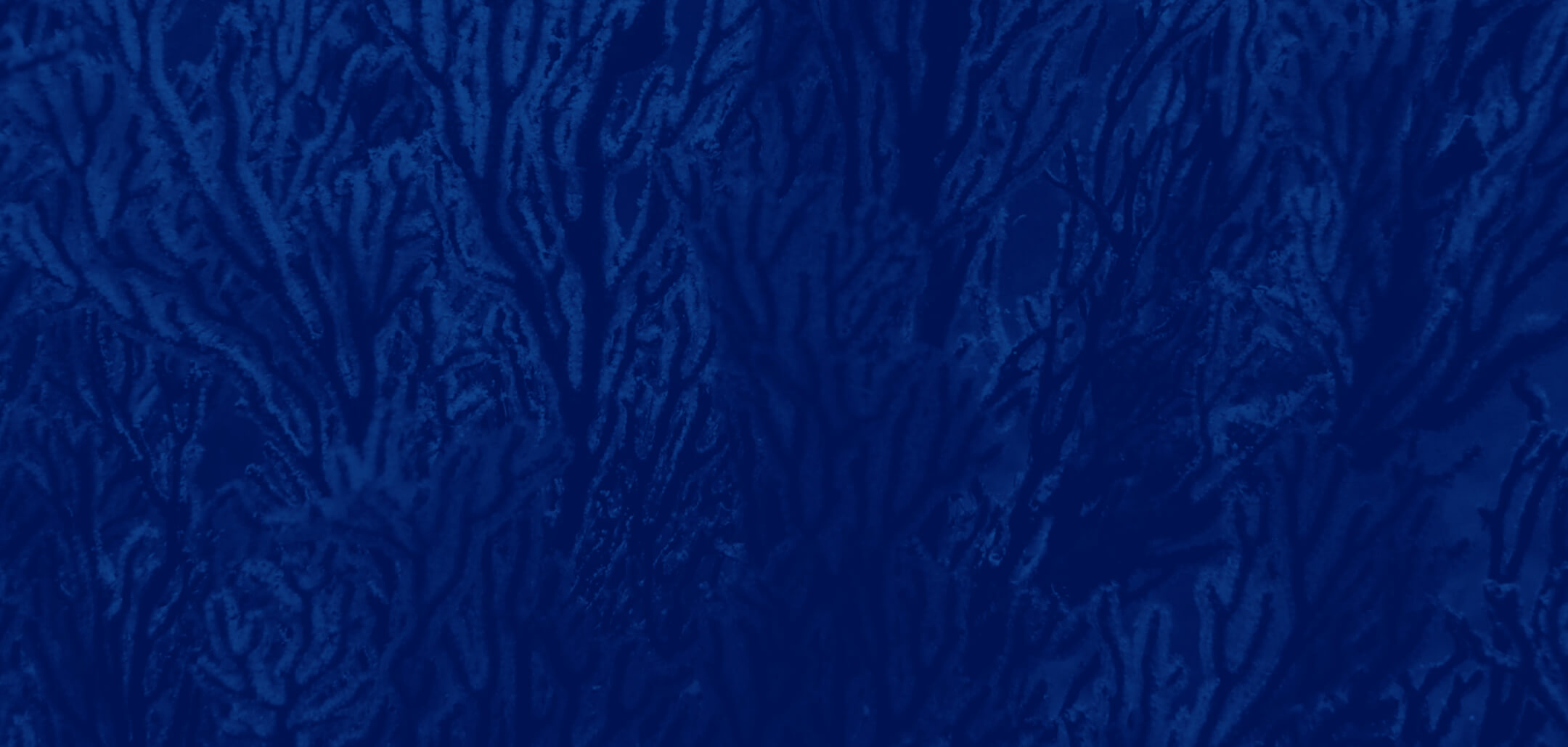
Additional Program Information
- Bricelj, V.M., Haubois A.-G., M. Sengco, R. Pierce, Culter J., D.M. Anderson. 2012. Trophic transfer of brevetoxins to the benthic macrofaunal community during a bloom of the harmful dinoflagellate Karenia brevis in Sarasota Bay, Florida. Harmful Algae: 16:27-34.
- Coultas, C.L., Culter, J.K., and F Reygadas. 2001. Soil Development under Black Mangroves on Isla Contoy, Q.R. Mexico. Soil Survey Horizons 42(2):37-42.
- Culter, J.K. (In Prep). Tidal Water Circulation within Karst Features of the west Florida Shelf Carbonate Platform.
- Culter, J.K., C. Bowen, J. Ryan, J. Perry, R. Janneman, W. Lin. 2013. Exploration of Deep Hole, Myakka River State Park, Florida. pp. 49-60. In: Proceedings Joint International Scientific Diving Symposium, American Academy of Underwater Sciences and European Scientific Diving Panel. Curacao, October 24-27, 2013.
- Culter, J.K. K. B. Ritchie, S. A. Earle, D. E. Guggenheim, R. B. Halley, K. T. Ciembronowicz, A. C. Hine, B. D. Jarrett, S. D. Locker, and W. C. Jaap. 2006. Pulley Reef: a deep photosynthetic coral reef on the West Florida Shelf, USA Coral Reefs (electronic publication of Springer-Verlag) DOI 10.1007/s00338-006-0097-6
- Culter, J.K., M.R. Milligan, J.R. Leverone, S. Mahadevan. 1991. Comparison of benthic macroinfauna among natural and planted Spartina alterniflora (Gramineae) and Halodule wrightii (Potamogetonacea) from Tampa Bay. In: Treat, S.F.; Clark, P.A., eds. Proceedings, Tampa bay Area Scientific Information Symposium 2. 1991 February 27 – March 1; Tampa, Fla. 528 p.
- Culter, J.K. and J.L. Simon. 1987. Sex ratios and the occurrence of hermaphrodites in the inarticulate brachiopod, Glottidia pyramidata (Stimpson) in Tampa Bay, Florida. Bulletin of Marine Science Vol. 40 (2):193-197.
- Culter, J.K. 1986. Manual for Identification of Marine Inver¬tebrates. A Guide to Some Common Estuarine Macroinvertebrates of the Big Bend Region, Tampa Bay, Florida. EPA/600 4 86/002, January 1986.
- Frischer, M.E., J.M. Danforth, L.C. Tyner, J.R. Leverone, D.C. Marelli, W.S. Arnold, and N.J. Blake. 2000. Development of an Argopecten-Specific 18S rRNA Targeted Genetic Probe. Mar. Biotechnol. 2, 11–20.
- Leverone, J.R., N.J. Blake, R.H. Pierce, and S.E. Shumway. 2006. Effects of the dinoflagellate Karenia brevis on larval development in three species of bivalve mollusc from Florida. Toxicon, 48(1):75-84.
- Leverone, J.R., S.E. Shumway and N.J. Blake. 2007. Comparative effects of the toxic dinoflagellate Karenia brevis on clearance rates in juveniles of four bivalve molluscs from Florida, USA. Toxicon, 49(5):634-645.
- Leverone, J.R., C.A. Luer, and J.M. Lawrence. 1991. Comparative Biochemistry and Physiology Part B: Comparative Biochemistry. 99(2)2: 259–264.
- Leverone, J.R., S.P. Geiger, S.P. Stephenson, and W.S. Arnold. 2010. Increase in Bay Scallop (Argopecten irradians) Populations Following Releases of Competent Larvae in Two West Florida Estuaries. Journal of Shellfish Research 29(2):395-406.
- Leverone, J.R, J.K. Culter, J.S. Sprinkel, M.R. Milligan, S. Mahadevan. 1991. Evaluation of long term studies of the benthic community in the vicinity of Big Bend, Tampa Bay. In: Treat, S.F.; Clark, P.A., eds. Proceedings, Tampa Bay Area Scientific Information Symposium 2. 1991 February 27 – March 1; Tampa, Fla. 528 p.
- Southward, E.C. and J.K. Culter. 1986. Discovery of Pogonophora in warm shallow waters of the Florida shelf. Mar. Ecol. Prog. Ser. (28):287 289.
Peer-reviewed Journal Articles & Symposium Proceedings
- Kurtz, B., J. Landmeyer, and J.K. Culter. 2024. Detection of periodic peaks in Karenia brevis concentration consistent with the time-delay logistic equation. Science of The Total Environment Volume 946, 10 October 2024, 13pp. DOI: 10.1016/j.scitotenv.2024.174061
- Kurtz, B., J. Landmeyer, and J.K. Culter. 2023. Precipitation, submarine groundwater discharge of nitrogen, and red tides along the southwest Florida Gulf coast. Heliyon: 9(5):1-19. https://doi.org/10.1016/j.heliyon.2023.e16046
- Culter, J.K., G. Byrd, E.R. Hall, C. Cole. 2023. Diving Techniques for Exploration of Submarine Karst Features of the West Florida Continental Shelf. In: editors, Diving for Science 2023. Proceedings of the American Academy of Underwater Sciences, 40th Scientific Symposium. U. of West Florida. Scott-Ireton, D., and A. Verde editors. pp: 1-13.
- Patin, N.V., Z.A. Dietrich, A. Stancil, M. Quinan, J.S. Beckler, E.R. Hall, J. Culter, C.G. Smith, M. Taillefert, F.J. Stewart. 2021. Gulf of Mexico blue hole harbors high levels of novel microbial lineages. The ISME Journal (2021) 15:2206–2232. https://doi.org/10.1038/s41396-021-00917-x
- Culter, J.K., C. Bowen, J. Ryan, J. Perry, R. Janneman, W. Lin. 2013. EXPLORATION OF DEEP HOLE, MYAKKA RIVER STATE PARK, FLORIDA. PROCEEDINGS
- JOINT INTERNATIONAL SCIENTIFIC DIVING SYMPOSIUM AMERICAN ACADEMY OF UNDERWATER SCIENCES and EUROPEAN SCIENTIFIC DIVING PANEL. M.A. Lang and M.D.J. Sayer, editors. Curaçao, October 24-27, 2013. pp:49-60
Meeting Presentation Abstracts
- Kurtz, B., J. Landmeyer, and J.K. Culter (presenter). 2024. New insights into the nature of Karenia brevis blooms: periodicity in cell concentration and how red tides are different from ordinary blooms. 12th US Symposium on Harmful Algae – 2024 Portland, Maine
- 2014 Culter, J.K., J.R. Leverone and M.C. Crosby. 2014. Recent Bay Scallop Restoration Activities in Sarasota Bay: Combining Science-Based Strategies and Community Involvement. National Shellfish Association 2014 Symposium, Jacksonville Florida.
- 2008 Culter, J.K. Exploration of the West Florida Shelf Blue Holes, Evidence of tidal pumping. American Academy of Underwater Sciences Annual Meeting, Scripps Institute of Oceanography, San Diego, CA, March 2008.
- 2008 Culter, J.K. and J.R. Leverone. Benthic Invertebrate Species Richness & Diversity at Different Habitats in the Greater Charlotte Harbor System. Charlotte Harbor Watershed Summit, March 25-27, 2008, Edison College Punta Gorda, FL.
- 2008 S.A. Grabe, J.K. Culter, and A. Janicki. Community Structure of the Benthos of Shell Creek and the Lower Peace and Myakka Rivers. Poster. . Charlotte Harbor Watershed Summit, March 25-27, 2008, Edison College Punta Gorda, FL.
- 2006 Culter, J.K. Exploration of the West Florida Shelf Blue Holes Investigation of Physical and Biological Characteristics and Archaeological Implications of Unique Karst Features. American Geophysical Union, Fall Meeting, San Francisco, California. December 11-15, 2006.
- 2006 Culter, J.K. Diving Methods used for the Exploration of the West Florida Shelf Blue Holes Investigation of Physical and Biological Characteristics and Archaeological Implications of Unique Karst Features. American Academy of Underwater Sciences Annual Meeting, Friday Harbor, Washington, February 27 – March 4.
- 2006 Culter, J.K. Pulley Ridge Expedition, The first Scientific Diving of the Deepest coral Reef in the United States. American Academy of Underwater Sciences Annual Meeting, Friday Harbor, Washington, February 27 – March 4.
- 2003 Culter, J.K., M.R. Sengco, J. Sprinkel, R.H. Pierce and D.M. Anderson. Benthic Response to application of phosphatic clay for the removal of Karenia brevis from the water column, Sarasota Bay, Florida. Poster presentation, with printed abstract. Second Symposium on Harmful Marine Algae in the U.S., December 9-13, Woods Hole Massachusetts. 1 Mote Marine Laboratory, 1600 Ken Thompson Parkway, Sarasota, Florida 34236-1096, USA, 2Woods Hole Oceanographic Institution, Woods Hole, MA 02540, USA
- 2003 Culter, J.K., and J.M. Sprinkel. Dissolved oxygen monitoring in the real and variable world, a case study of spatial and temporal variance. Poster presentation, with printed abstract. BASIS 4, The 4th Tampa Bay Area Scientific Information Symposium. October 27-30.
- 2003 Culter, J.K., J.M. Sprinkel, and G. Kirkpatrick. Effects of entrainment and temperature increase on Phytoplankton; A novel use of HPLC pigment analysis and particle size analysis. Oral presentation, with printed abstract. BASIS 4, The 4th Tampa Bay Area Scientific Information Symposium. October 27-30.
- 2003 Culter, J.K., and J.M. Sprinkel. Effects of thermal effluent on the benthos of the Big Bend Area of Hillsborough Bay. Poster presentation, with printed abstract. BASIS 4, The 4th Tampa Bay Area Scientific Information Symposium. October 27-30.
- 2003 Culter, J.K., J.M. Sprinkel, and E. Estevez. An investigation of relationships between freshwater inflows and benthic macroinvertebrates in the Alafia River Estuary. Poster presentation, with printed abstract. BASIS 4, The 4th Tampa Bay Area Scientific Information Symposium. October 27-30.
- 2001. Culter, J.K. Salinity and benthic macroinvertebrate zonation io the lower Peace River, southwest Florida. Estuarine Research Federation annual meeting, poster presentation. November 2001.
- 1992. Culter, J.K. Effects of the Anclote Power Plant thermal effluent on the Seagrass Thalassia testudinum. Florida Scientist v. 55. Suppl. 1, p. 10.
- 1992. Culter, J.K. and J. Leverone. Effects of the Anclote Power Plant Thermal Effluent on Seagrass Associated Infauna. Florida Scientist v. 55. Suppl. 1, p. 15.
- 1991. Culter, J.K. and G. Blanchard. Image Analysis as a Tool for Environmental Studies of Seagrasses and Benthic Habitats. Florida Scientist v. 54. Suppl 1, p.13.
- 1987. Stevely, J., J. Culter and E. Estevez. Bottom dwelling animals of Sarasota Bay. Sarasota Bay Area Scientific Information Symposium. Sarasota, FL. April.
- 1985. Culter, J.K. Distribution of benthic macroinvertebrates along salinity gradients of four west coast river systems. Florida Scientist v. 48. Suppl. 1, p. 34.
- 1981. Culter, J.K. et al. Bathymetry and sedimentology of the nearshore Gulf of Mexico off Pinellas County, Florida. The 44th Annu. Meet. of Fla. Acad. of Sci. (Abstr. in Fla. Sci., Vol. 44, Suppl. 1:44.)
- 1981. Culter, J.K. et al. Benthic soft bottom macroinfauna of the nearshore Gulf of Mexico off Pinellas County, Florida. The 44th Annu. Meet. of Fla. Acad. of Sci. (Abstr. in Fla. Sci. Vol. 44, Suppl. 1:24.)
- 1980. Culter, J.K. The occurrence of hermaphrodites in the inarti¬culate brachiopod, Glottidia pyramidata. Paper presented at the Fla. Acad. of Sci. 44th Annu. Meet., March 23 25, 1980.
- 1979. Culter, J.K. A population study of the inarticulate brachio¬pod, Glottidia pyramidata (Stimp¬son). M.A. Thesis, Univ. of So. Fla.
- 1976. Culter, J.K. Genetic variation in a natural population of the lingulid brachiopod Glottidia pyramidata. The 40th Annu. Meet. of Fla. Acad. of Sci. (Abstr. in Fla. Sci. 39 1:5).
- 1976. Conner, W.G. and J.K. Culter. Changes in the sediment structure associated with the mining of fossil oyster shell. The 40th Annu. Meet. of Fla. Acad. of Sci. (Abstr. in Fla. Sci. 39 1:2).

